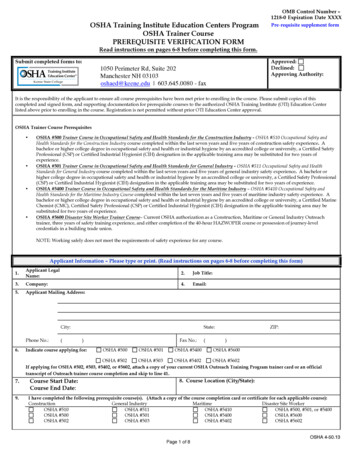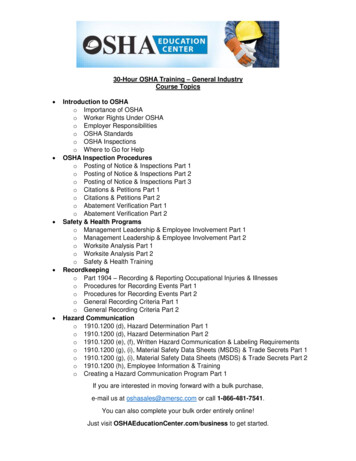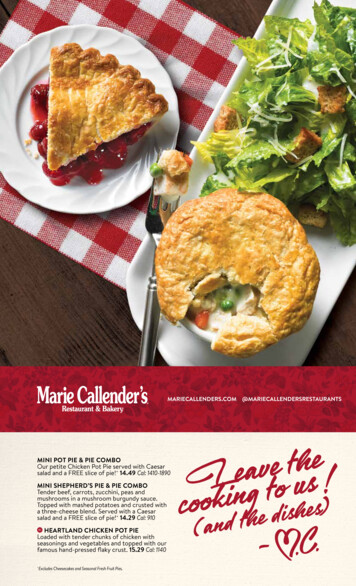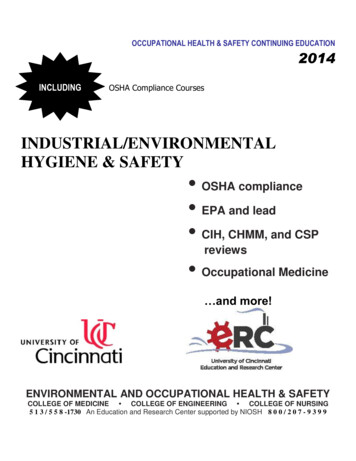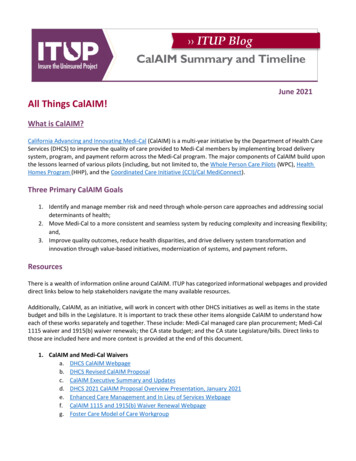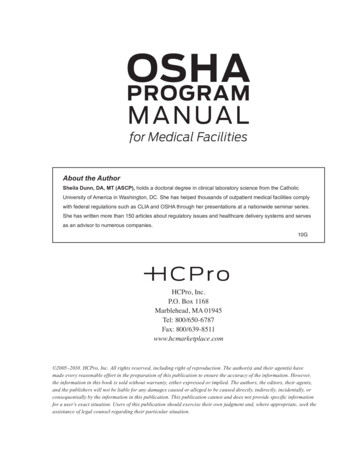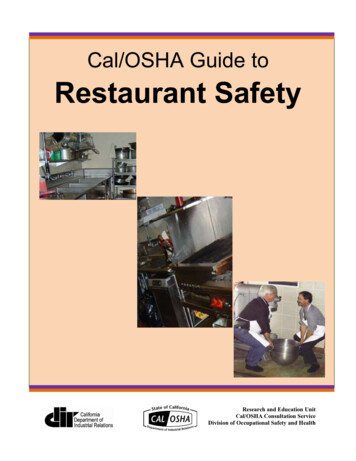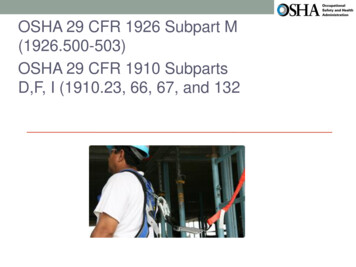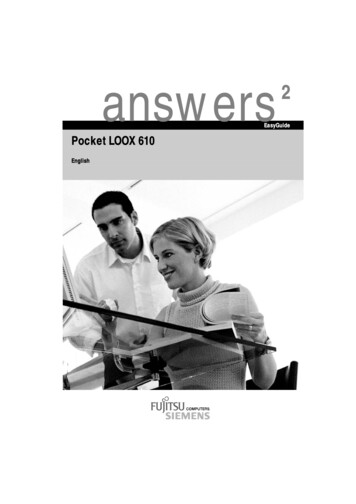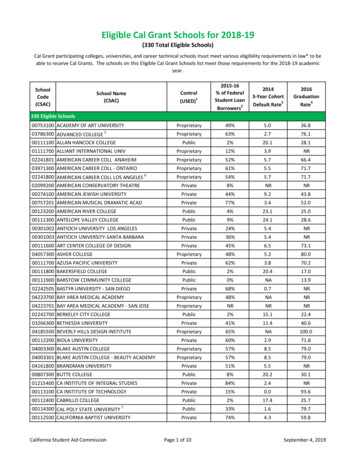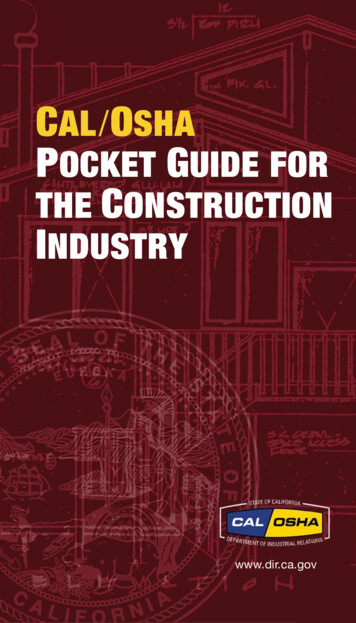
Transcription
CAL/ OSHAPOCKET GUIDE FORTHE CONSTRUCTIONINDUSTRYwww.dir.ca.gov
Table of ContentsAbout This Pocket Guide . 4Workplace Safety and Health. 4Access. 5Administrative Requirements . 7This Guide . . .does not provide full legal interpretation of Cal/OSHAregulations or their underlying statutes.Readers should refer directly to Cal/OSHA Title 8regulations in the California Code of m)and to the California Labor Code ml) for detailed information regardingthe scope, specifications, and exceptions of a particularregulation and for other requirements that may be applicableto their operations.Aerial Devices and Elevating Work Platform Equipment. 11Airborne Contaminants and Dust . 12Air Compressors. 13Asbestos . 13Blasting (Abrasives/Sand). 18Blasting (Explosives) . 18Carcinogens . 20Code of Safe Practices . 21Publications Unit – Updated June 2019Competent Person. 21Produced by the California Department of Industrial Relations(DIR), Division of Occupational Safety and Health (Cal/OSHA).Concrete Construction . 21To obtain copies of Cal/OSHA safety and health publications,contact a Cal/OSHA Consultation Services office listed in the backof this booklet, or go to www.dir.ca.gov/dosh/puborder.asp.Confined Spaces . 26Corrosive Liquids. 29Cranes. 29Demolition . 38Dust, Fumes, Mists, Vapors, and Gases . 40Electrical. 41Elevators, Lifts, and Hoists . 46Emergency Medical Services. 47Engine Exhaust Emission . 48Erection and Construction. 48Ergonomics in Construction . 52Cal/OSHA Pocket Guide for the Construction Industry June 2019 i
Excavation, Trenches, and Earthwork . 53Explosion Hazards. 62Fall Protection. 63Fire Protection and Prevention. 68Roofing Operations. 113Scaffolds. 118Silica Dust . 132Stairways . 133Temporary Agencies. 134First Aid . 69Flaggers . 69Flammable and Combustible Liquids . 70Forklifts. 71Toeboards . 135Toilets/Washing Facilities/Sanitation . 136Tools and Equipment . 137Traffic Control . 143Forms, Falsework, and Vertical Shoring. 73Training . 143Guardrails. 75Tunnels and Tunneling . 145Hazard Communication Program (HAZCOM). 77Welding, Cutting, and Other Hot Work . 147Heat Illness Prevention . 79Wood Preservative Chemicals . 150Heavy Construction Equipment. 87Work Over or Near Water . 151Hot Pipes and Hot Surfaces. 89List of Acronyms . 152Housekeeping/Site Cleaning . 90Index . 155Injury and Illness Prevention Program. 90Ladders . 93Laser Equipment. 98Lead . 99Lighting. 102Lock-out/Block-out Procedures . 103Machine Guarding . 106Multi-employer Worksites. 106Personal Protective Equipment . 107Pile Driving . 109Pressurized Worksites . 111Qualified Person . 112Ramps and Runways. 113ii Cal/OSHA Pocket Guide for the Construction Industry June 2019Cal/OSHA Pocket Guide for the Construction Industry June 2019 iii
About This Pocket GuideThe construction industry involves many types of work activitiescovered by numerous regulations in title 8 of the California Code ofRegulations (T8 CCR). T8 CCR contains detailed information onregulations and workplace safety programs, includingspecifications and exceptions. Construction employers may haverequirements in the Construction Safety Orders (CSOs), ElectricalSafety Orders (ESOs), Tunnel Safety Orders (TSOs), CompressedAir Safety Orders (CASOs), and the General Industry SafetyOrders (GISOs).To assist the construction industry in working safely andcomplying with title 8 regulations, the Cal/OSHA PublicationsUnit has updated this Pocket Guide. This guide is intended to beused as a reference for workers, employers, supervisors, jobstewards, safety personnel, and others. This Pocket Guide: Summarizes safety requirements from T8 CCR thatapply to the construction industry. It is not meant to beeither a substitute for or a legal interpretation of theoccupational safety and health regulations in T8 CCR(see T8 CCR or detailed information).work together to ensure that safety and health are always partof the decisions made and all employees and supervisors arefully trained to work safely. The benefits of effective, proactivesafety programs include higher productivity and employee morale, higher quality of work and products produced, fewer worker injuries, lower compensation insurance cost and absenteeism, and lower employee turnover.A written Injury and Illness Prevention Program (IIPP) should be thefoundation for all of your other safety and health programs and isrequired for every workplace regulated under title 8 of the CaliforniaCode of Regulations (T8 CCR). A summary of the basic elementsof an IIPP has been included in the Injury and Illness PreventionProgram section of this guide. Employers are also encouraged touse Cal/OSHA's IIPP eTool (www.dir.ca.gov/dosh/etools/09031/index.htm) to develop a specific IIPP tailored to their ownworkplaces. Lists the major subject headings in alphabetical order inthe Table of Contents, and each subject heading is linkedto its content.Remember, the effectiveness of all your safety programs dependon how well you actually implement and maintain them. You mustregularly review and update your programs in order to keep themeffective. Employers and employees must also remember that theregulations in T8 CCR only set minimum requirements and theyshould strive to exceed the standards at all times. Provides highlights of selected safety standards in eachmajor subject heading within its scope and may alsoinclude best practices in safety and health.For safety and health related assistance, employers andemployees may contact the nearest Cal/OSHA ConsultationOffice listed on the back cover of this guide. Is not all-inclusive. The contents under the bullets,lists, notes, and exceptions are highlights ofregulatory requirements, best practices, and otherconstruction safety and health information. Readersshould refer directly to T8 CCR for completeinformation. Contains abbreviations as described in the List of Acronymssection. It is available in PDF format and can be printedonline.Workplace Safety and HealthAccessThe employer must provide safe access to and from all worklevels or surfaces. Regulated means of access are as follows:A. Stairways, ramps, or ladders must be provided at all pointswhere a break in elevation of 18 inches or more occurs in afrequently traveled passageway, entry, or exit. 1629(a)(3)B. Aerial devices, such as cherry pickers and boom trucks,may be vehicle-mounted or self-propelled and used toposition employees, tools, and materials. 3637, and 3648Proactive safety and health programs are an effective way toprevent workplace injuries and illnesses and reduce the costsof doing business. In such programs employers and employees4 Cal/OSHA Pocket Guide for the Construction Industry June 2019Cal/OSHA Pocket Guide for the Construction Industry June 2019 5
C. Elevating work platforms, such as vertical towers and scissorlifts, are designed to raise and hold a work platform in asubstantially vertical axis. 3637, and 3642D. Industrial trucks, such as rough terrain forklifts, may be used toelevate and position workers under specific conditions. 3657E. Elevators (construction) are required as follows:1.For structures or buildings 60 ft. or more above groundlevel or 48 ft. below ground level. 1630(a)2.At demolition sites of seven or more stories or 72 ft. ormore in height. 1735(r)Note: Elevators must be inspected and tested in thepresence of a DOSH representative before use. A permitfrom DOSH is required before operating. 1604.29(a)F. Personnel hoists may be used at special construction sites,such as bridges and dams, if approved by a registeredengineer. 1604.1(c)Administrative RequirementsEmployers must meet certain administrative requirementsthat may include Cal/OSHA notification, specific registration,permitting, certification, recordkeeping, and the posting ofinformation in the workplace. Some of these requirementsdepend on the construction trade or type of activity in whichemployers are involved. The more common requirements arelisted below:A. Documents required at the job site include the following:1. Injury and Illness Prevention Program: Program documentmay be kept in the office.1509(a), and 3203(a)2. Code of Safe Practices. 1509(b)3. All Cal/OSHA-required permits. 3414. All Cal/OSHA-required certifications. VariousG. Ladders can be used to gain access to working surfacesabove and below ground level under certain conditions. 16755. Respiratory Protection Program for all work sites whererespirators are mandatory. 5144(c)H. Ramps and runways provide means of access for foot orvehicle traffic. 1623, 1624, and 16256. Heat illness prevention. 3395I.Stairways must be installed in buildings that have two or morestories or are 24 ft. or more in height. 1629(a)(1)7. Fall protection plan, if required. 1671.1B. Postings required at the job site include the following:1.For buildings of two or three stories, at least one stairway isrequired. 1629(a)(4)1. Cal/OSHA poster "Safety and Health Protection on theJob." 3402.For buildings of more than three stories, two or morestairways are required. 1629(a)(4)2. Code of Safe Practices. 1509(b), and (c)J. The following routes of access are prohibited:1.Endless belt-type manlifts. 1604.1(a)(3)2.Single-cleat ladders more than 30 ft. or double-cleatladders more than 24 ft. long. 1629(c)3.Cleats nailed to studs. 1629(b)4.Rides on loads, hooks, slings, or concrete buckets ofderricks, hoists, or cranes. 1718(a), and 1720(c)(3)3. Emergency phone numbers. 1512(e)4. Employee access to records notification to informemployees that they have the right to gain access tomedical and exposure records. 3204(g)5. Operating permit for air tanks. 461(a)6. Operating rules for industrial trucks and tow tractors(if used), where employees operate forklifts. 3664, and 3650(c)7. Authorized access at controlled access zones (CAZs).1671.1, and 1671.28. Variance process. 411.39. Cal/OSHA registration. 341.4, and 341.1010.6 Cal/OSHA Pocket Guide for the Construction Industry June 2019Citations. 332.4Cal/OSHA Pocket Guide for the Construction Industry June 2019 7
11.Hazard warning signs at the following job sites:a. Where asbestos work is being done. 341.10, and 1529(k)b. Where lead work is being done. 1532.1(m)c. At confined spaces. Article 37, 5158d. At controlled access zones. 1671.2e. On cranes, concrete pumps, high-lift trucks, etc.,(high-voltage warning signs). 2947, Group 13f. On powder-actuated tools. 1691(n)g. On lasers (laser levels, etc.). 1801(d)h. On air compressors with an automatic-startfunction. 3320C. Recordkeeping requirements are included in T8 CCR for thepurpose of establishing a historical record of compliance.These requirements include the following:1. Cal/OSHA Log 300.Note: You can download a package of forms and instructionsfor Log 300 recordkeeping from the Cal/OSHA ConsultationServices on the Internet tml andclick on “Forms and Instructions.”2. Lock-out/block-out activity records. 33143. Operation and maintenance activity records. 1509, and 32034. Medical surveillance program and records.5. Training records.6. Inspection records.D. Reports and notifications to Cal/OSHA must be made of thefollowing incidents and activities:1. Serious injury or illness, or death. A report must be madeimmediately by telephone (within 8 hours) to a districtoffice. Employers are allowed 24 hours if they can showthat circumstances prevented the report from being madewithin 8 hours. 342(a)Note: A serious injury or illness is defined as one thatrequires inpatient hospitalization for other than medicalobservation or diagnostic testing, or when an employeesuffers an amputation, the loss of an eye, or any seriousdegree of permanent disfigurement. 330(h)8 Cal/OSHA Pocket Guide for the Construction Industry June 20192. Blasting accidents or unusual occurrences. A report mustbe forwarded to the district office within 24 hours. 5248(a)3. Construction activities annual permit. Employers governedby an annual permit must notify DOSH before starting thework. 341.1(f)4. Asbestos-related work. The DOSH district office must benotified 24 hours before starting work that is subject toregistration. 341.9(a)5. Use of regulated carcinogens. The employer must reportoperations involving the use of a regulated carcinogenwithin 15 days. 52036. Construction involving lead-work. Written notification mustbe made to the DOSH district office 24 hours beforestarting work. 1532.1(p)E. Employers should promptly notify affected employees of themonitoring results of ANY required monitoring for regulatedsubstances. Such notifications must be made within therequired time frame. Some common substances requiringnotification include:1. Asbestos, methylenedianiline, cadmium, chromium (VI),and lead: Notify within 5 working days following receipt ofmonitoring results. 1529(f)(5)(A), 1535(f)(7)(A),1532(d)(5)(A), 1532.2(d)(4)(A), 1532.1(d)(8)(A)2. Vinyl chloride: Notify within 15 working days followingreceipt of monitoring results. 5190(d)(4)(A), 5210(d)(6)3. Formaldehyde: Notify within 15 days following receipt ofmonitoring results. 5217(d)(6)F. Project or Annual permits issued by Cal/OSHA are requiredfor various construction activities. 341A Project Permit is required for: 341(d) Use of diesel engines in any mine or tunnel. Demolition or dismantling of a structure more than 36 ft. high.341(d)(3) Erecting/raising/lowering or dismantling a fixed tower crane.An Annual Permit is required for employers when thestructure is over 36 ft. high and employers are engaged inthe following activities: 341(d)(4) Erection and placement of structural steel orstructural members other than steel. Installation of curtain walls/precast panels or fascia.Cal/OSHA Pocket Guide for the Construction Industry June 2019 9
Installation of metal or other decking. Forming or placement of concrete structures/decks onsteel structures. Installation of structural framing (including roof framing)or panelized roof systems.Annual or Project Permit is needed for: Construction of trenches or excavations 5 ft. or deeperinto which a person is required to enter. Erection and placement of scaffolding, vertical shoring,or falsework more than 36 ft. high.Operating permit is required for: Operating specified air compressors. 461 Operating tower cranes if the employer is subject to341, 341.1, and 344.70.Note: Most permits can be obtained from a DOSH districtoffice. A safety conference and a review of the employer’ssafety program will be scheduled before permit issuance.341.1(c)Exception: Permit requirements do not apply to certainactivities. See 341(e).G. Certification requirements are necessary in the followingcircumstances:1. Power operated cranes and derricks exceeding 3 tonsrated capacity shall not be used in lifting service until theequipment has been certified by a DOSH licensed certifier.1610.92. Operators of mobile and tower cranes must have a validcertificate. See exceptions. 1618.13. Asbestos consultants and site surveillance techniciansmust be certified by DOSH. 341.154. Training certification is required for many activities andtrades (see specific Safety Orders). Title 8H. Registration and licensing are required in the followingcircumstances:1. Asbestos registration. An employer must register withDOSH when engaged in asbestos-related work on 100 sq.ft. or more of surface area. 341.610 Cal/OSHA Pocket Guide for the Construction Industry June 20192. Blaster's License. The blaster must be a licensed blasteror directed by a licensed blaster and be at least 21 yearsof age. 5238Aerial Devices and ElevatingWork Platform EquipmentA. Aerial devices, such as cherry pickers and boom trucks, maybe vehicle-mounted or self-propelled and used to positionemployees. 3637General safety requirements are as follows: 36481. Only authorized persons may operate aerial devices.3648(c)2. Aerial devices must not rest on any structure. 3648(a)3. Controls must be tested before use. 3648(b)4. Workers must stand only on the floor of the basket. Noplanks, ladders, or other means are allowed to gaingreater heights. 3648(e)5. A fall protection system must be worn and attached to theboom or basket. 3648(o)6. Brakes must be set when employees are elevated. 3648(g)7. An aerial lift truck must not be moved when an employeeis on the elevated boom platform except under conditionslisted in 3648(l).B. Elevating work platform equipment, such as vertical tower,scissor lift, and mast-climbing work platform, may be used toposition employees and materials 3642.General safety requirements are as follows: 36421. The platform deck shall be equipped with a guardrail orother structure around its upper periphery. Where theguardrail is less than 39 inches high, a personal fallprotection system is required. 3642(a)2. The platform shall have toeboards at sides and ends.3642(f)(1)3. No employee shall ride, nor tools, materials, or equipmentbe allowed on a traveling elevated platform. Seeexceptions. 36464. Units shall not be loaded in excess of the design workingload. 3646(f)Cal/OSHA Pocket Guide for the Construction Industry June 2019 11
C. The following information must be displayed on the device:3638(c)1. Manufacturer's name, model, and serial number.Note: Check Table AC-1 frequently as the content is regularlyupdated; and employers must display the required warning signs inwork areas where hazardous contaminants and dust are present.2. Rated capacity at the maximum platform height andmaximum platform travel height.Air Compressors3. Operating instructions.General requirements for air compressors include:4. Cautions and restrictions.A. Employers must obtain a DOSH permit for the air tanks of aircompressors operated at a work site. 461(a)D. Devices must be designed to applicable American NationalStandards Institute (ANSI) standards. 3638(b)Note: See clearances for operations near high-voltageconductors in the Electrical section of this guide.Airborne Contaminants and DustThe employer must control employees' exposures to airbornecontaminants and employees' skin contact with thosesubstances identified in Table AC-1 of 5155 and 1528. Airbornecontaminants suspended in the air can exist in different forms,including gases, vapors, and particulates (particles of eitherliquids or solids). Table AC-1 contains the Permissible ExposureLimits (PELs) for these substances. The PEL applies to the sumof the exposures to the substance in the vapor state and fromthe particulate fraction. 5155Some of the substances listed in Table AC-1 also have specificperformance standards, noted in the CSOs and the GISOs,for controlling employee exposure. These substances includeasbestos (1529); cadmium (1532); lead (1532.1); benzene (5218);methylenedianiline (1535); beryllium (1535.1); concrete andmasonry materials (1530.1); chromium (VI) (1532.2); respirablecrystalline silica (1532.3); carbon monoxide (5155); internalcombustion engines (1533), vinyl chloride (5210); and weldingfumes (1536, 1537).Airborne contaminants must be controlled by: 5141 Applying engineering controls. Removing employees from exposure to the hazard andby limiting the daily exposure of employees to thehazard. Exception: No permit is required for tanks with a diameter ofless than 6 inches, tanks equipped with a safety valve set toopen at no more than 15 psi pressure, or tanks having avolume of 1 1/2 cu. ft. or less with a safety valve set to openat no more than 150 psi. 461(f)B. Warning signs are required for electric air compressorsequipped with an automatic-start function. 3320C. Safety valves must be popped weekly. 1696(d)D. Air tanks must be drained per manufacturer'srecommendation. 1696(c)E. Fans shall be guarded with a shroud or side screens. 1696(b)F. Portable air compressors on wheels must be prevented fromrolling. 1696(a)AsbestosThe word "asbestos" refers to six naturally occurring, fibrous,hydrated mineral silicates that differ in chemical composition.They are actinolite, amosite, anthophyllite, chrysotile,crocidolite, and tremolite. Nonfibrous forms of the last threeminerals listed here are regulated by GISO 5208.1. You mayencounter asbestos at a construction site in the followingapplications and areas: Excavations where asbestos-bearing rock outcroppingsare at or near the surface. Fireproofing for steel-frame high-rise buildings. Pipe and boiler insulation.Providing respiratory protective equipment wheneversuch engineering controls are not practical or fail toachieve full compliance.12 Cal/OSHA Pocket Guide for the Construction Industry June 2019Cal/OSHA Pocket Guide for the Construction Industry June 2019 13
Insulators of electrical conductors. Plaster, cement, drywall, and taping compounds. Floor tile and tile adhesives. Acoustical ceilings (tiles and sprayed on). Asbestos-cement piping, shingles, and panels. Roofing felt and sealing compounds.Because asbestos exposure has been linked to seriousillnesses, Fed/OSHA and Cal/OSHA have implemented strictregulations to minimize exposures to work site and "take-home"asbestos. Below is a summary of regulatory requirements:A. Construction projects are subject to regulation under 1529 ifthey involve one or more of the following activities, regardlessof the percentage of asbestos present:1. Demolition or salvage of structures where asbestos ispresent.2. Removal or encapsulation (including painting) ofmaterials that contain asbestos.B. Cal/OSHA administrative requirements are as follows:1. Registration and district office notification if disturbing100 sq. ft. or more of manufactured constructionmaterials containing more than 1/10 of 1% ofasbestos-containing construction material (ACCM).341.6(a)2. Carcinogen notification with exposures in excess ofpermissible exposure limits (PELs).3. The employer shall notify affected employees of themonitoring results of asbestos within 5 working daysfollowing receipt of monitoring results. 1529(f)(5)(A)4. DOSH certification is required for all persons performingduties of an asbestos consultant or technician. 341.15(a)5. "Asbestos consultant" means any person who contractsto provide professional health and safety services relatingto asbestos. 1529(q)(1)C. Training is required for all employees engaged in ClassI through IV work and all work in which they are likely tobe exposed in excess of the PELs. The training must beprovided:3. Construction, alteration, repair, maintenance, orrenovation of structures, substrates, or portions thereofthat contain asbestos.1. At the employer's expense.4. Installation of products that contain asbestos.3. Annually after initial training.5. Erection of new and the improvement, alteration,and conversion of existing electric transmission anddistribution lines and equipment.4. In accordance with 1529(k)(9).6. Excavation that may involve exposure to naturallyoccurring asbestos, excluding asbestos mining and millingactivities.7. Routine facility maintenance.8. Transportation, disposal, storage, and containment ofand site housekeeping activities involving asbestos ormaterials containing asbestos.9. Asbestos spills and emergency cleanups.Regulatory requirements for work activities subject to 1529 varydepending on the percent, amount, or type of asbestos-containingmaterials involved. Listed below are selected requirements and theactivities to which they apply:14 Cal/OSHA Pocket Guide for the Construction Industry June 20192. Before or at the time of initial assignment.D. Permissible exposure limits (PELs): The employer must ensurethat employee exposures do not exceed: 1529(c)1. Eight-hour time-weighted average of 0.1 fibers/cc.2. Thirty-minute excursion limit of 1 fiber/cc. 1529(c)E. Multi-employer work sites are regulated under 1529:1. The general contractor on the project must exercisegeneral supervisory authority. 1529(d)2. An employer performing work that involves asbestosmust notify other employers at the site. 1529(d)3. All employers on site must ensure that their ownemployees are not exposed to asbestos fibers due to abreach in containment or control methods used by thecreating employer. 1529(d)Cal/OSHA Pocket Guide for the Construction Industry June 2019 15
F. Exposure assessments and monitoring are requiredas follows:2. Vacuum cleaners with high-efficiency particulate air (HEPA)filters must be used to clean up ACM and presumedasbestos-containing material (PACM). 1529(g)(1)1. Initial exposure assessment must be made by allemployers subject to 1529 before or at the onset of theproject. 1529(f)(2)3. Prompt cleanup and disposal in labeled leak-tightcontainers are required except as specified in 1529(g)(8)(B),1529(g)(1).2. Daily exposure monitoring of employees must beconducted by all employers disturbing materials thatcontain more than 1% asbestos in Class I and II work.1529(f)(3)4. Specific work practices for different activities are alsooutlined in 1529, 1529(g) (4-11)5. Stripping of finishes shall be conducted using low abrasionpads at speeds lower than 300 rpm and wet methods.1529(g)3. All employers must monitor daily representative exposureof employees performing Class I and II work.Exceptions 1529(f)(3):No monitoring required when:» The employer has made a negative exposureassessment for the entire operation.» Employees are equipped with supplied-air respirators(SARs) operated in the pressure demand mode, orother positive pressure mode respirator. However,employees performing Class I work using certaincontrol methods shall be monitored daily even if theyare equipped with SARs.4. Periodic exposure monitoring of employees must beconducted when disturbing asbestos-containing materials(ACMs) in operations involving other than Class I
Housekeeping/Site Cleaning90\n Injury and Illness Prevention Program90\n Ladders 93\n Laser Equipment98\n Lead 99\n Lighting102\n Lock-out/Block-out Procedures 103\n Machine Guarding 106\n . It is available in PDF format
